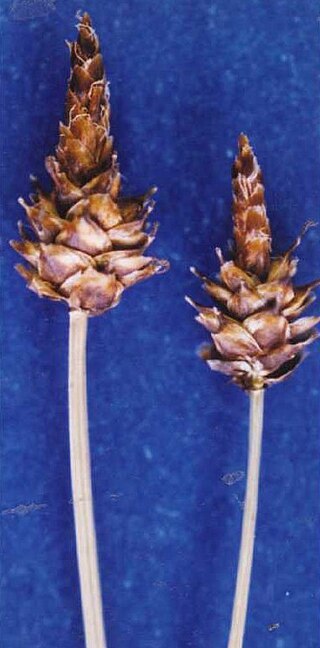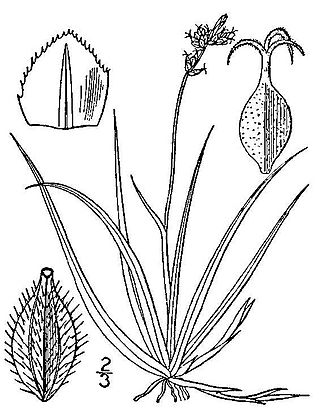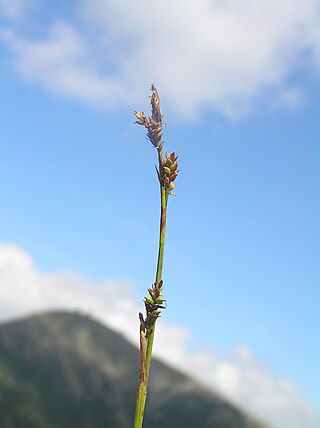
A marsh is — according to ecological definitions — a wetland that is dominated by herbaceous rather than woody plant species. More in general, the word can be used for any low-lying and seasonally waterlogged terrain. In Europe and in agricultural literature low-lying meadows that require draining and embanked polderlands are also referred to as marshes or marshland.

Rhynchospora alba, the white beak-sedge, is a plant in the sedge family, Cyperaceae. It is a tufted herbaceous perennial around 50 cm tall, with white inflorescences that flower in August. The fruit of the sedge is a small achene with a characteristic beak-like cap. It is dispersed by wind or falls by gravity, leading to individuals existing in tight clumps. The species favours wet, acidic and nutrient poor soils, thriving in Sphagnum-dominated bogs, but also peaty grasslands. As such, it is often used as a positive indicator for bog and mire ecosystem health.

Carex capitata is a species of sedge known by the common name capitate sedge. It has a circumboreal distribution including Norway, Russia, Siberia, Alaska, Canada and Greenland. Growing in wet places in boreal forests and mountain meadows in alpine climates.

Carex disperma is a species of sedge known by the common names softleaf sedge or two-seed sedge. It is native to much of the northern Northern Hemisphere, from Alaska to Greenland, most of Canada and the contiguous United States, and across Eurasia.

Schoenoplectus americanus is a species of flowering plant in the sedge family known by the common names chairmaker's bulrush and Olney's three-square bulrush. It is native to the Americas, where it is known from Alaska to Nova Scotia and all the way into southern South America; it is most common along the East and Gulf Coasts of the United States and in parts of the western states. It grows in many types of coastal and inland wetland habitat, as well as sagebrush, desert scrub, chaparral, and plains. This rhizomatous perennial herb easily exceeds two meters in height. The stiff stems are sharply three-angled and usually very concave between the edges. Each plant has three or fewer leaves which are short and narrow. The inflorescence is a small head of several spikelets which may be brown to bright orange, red, purplish, or pale and translucent. They have hairy edges. The fruit is a brown achene. The plant reproduces sexually by seed and colonies spread via vegetative reproduction, sprouting from the rhizomes.

Calamovilfa longifolia is a species of grass known by the common names prairie sandreed and sand reedgrass. It is native to North America, where it occurs from the Northwest Territories to Ontario in Canada and as far south as New Mexico and Kansas in the United States. There are two varieties, var. longifolia being widespread in the species' range and var. magna being native to the Great Lakes region.

Calamagrostis montanensis is a species of grass known by the common names plains reedgrass and prairie reedgrass. It is native to North America, where it is found across Canada from British Columbia to Manitoba and south to Colorado in the United States.

Carex bigelowii is a species of sedge known by the common names Bigelow's sedge, Gwanmo sedge, and stiff sedge. It has an Arctic–alpine distribution in Eurasia and North America, and grows up to 50 centimetres (20 in) tall in a variety of habitats.

Carex concinna is a species of sedge known by the common names low northern sedge, northern elegant sedge, beauty sedge, and beautiful sedge. It is native to northern North America, where it occurs across Canada and in high elevations in the northern contiguous United States.

Carex inops is a species of sedge known as long-stolon sedge and western oak sedge. It is native to northern North America, where it occurs throughout the southern half of Canada and the western and central United States.

Carex livida is a species of sedge known by the common names livid sedge and pale sedge.

Carex vaginata is a species of sedge known by the common name sheathed sedge.

Eriophorum viridicarinatum is a species of sedge known by the common names thinleaf cottonsedge, green-keeled cottongrass, and bog cottongrass. It is native to northern North America, where it occurs in Alaska and throughout much of Canada, its range extending into the northern contiguous United States. Its distribution is more patchy in the west but it is widespread in eastern Canada.

Kobresia simpliciuscula is a species of sedge known by the common names false sedge, simple bog sedge and simple kobresia. It has a circumpolar distribution, occurring throughout the northern latitudes of the Northern Hemisphere.

Panicum repens is a species of grass known by many common names, including torpedo grass, creeping panic, panic rampant, couch panicum, wainaku grass, quack grass, dog-tooth grass, and bullet grass. Its exact native range is obscure. Sources suggest that the grass is native to "Africa and/or Asia", "Europe or Australia", "Eurasia", "Australia", "Europe, Asia, and Africa", or other specific regions, including the Mediterranean, Israel, and Argentina. It is present in many places as an introduced species and often a noxious weed. It has been called "one of the world's worst weeds."

Hilaria mutica, synonym Pleuraphis mutica, is a species of grass known by the common name tobosa, or tobosa grass. It is native to Northern Mexico, and the Southwestern United States, in Arizona, New Mexico, Oklahoma, and Texas.

Poa fendleriana is a species of grass known by the common name muttongrass. It is native to western North America, where its distribution extends from western Canada to northern Mexico.

Vaccinium oxycoccos is a species of flowering plant in the heath family. It is known as small cranberry, marshberry, bog cranberry, swamp cranberry, or, particularly in Britain, just cranberry. It is widespread throughout the cool temperate northern hemisphere, including northern Europe, northern Asia and northern North America.

Carex lacustris, known as lake sedge, is a tufted grass-like perennial of the sedge family (Cyperaceae), native to southern Canada and the northern United States. C. lacustris us an herbaceous surface-piercing plant that grows in water up to 50 cm (1.6 ft) deep, and grows 50–150 cm (1.6–4.9 ft) tall. It grows well in marshes and swampy woods of the boreal forest, along river and lake shores, in ditches, marshes, swamps, and other wetland habitat. It grows on muck, sedge peat, wet sand or silt, in filtered or full sunlight.

Carex ventosa, also known as Chatham Islands forest sedge, is a tussock-forming species of perennial sedge in the family Cyperaceae. It is native to the Chatham Islands.




















